It's a gloomy trying to rain day in Wyoming and I've been dyeing Lincoln wool and a superwash Columbia Rambouillet wool roving. I've been doing this for years and the process is pretty automatic to me. Clean wool, stuff in canning jars, make dye, add dye, heat set, let cool, dry, spin. Today I looked at the curly Lincoln wool and squished roviing in the jars and noticed something- the play of color and texture is actually very intriguing. So much, that I took the pictures you see below. Maybe I should pay attention more often.
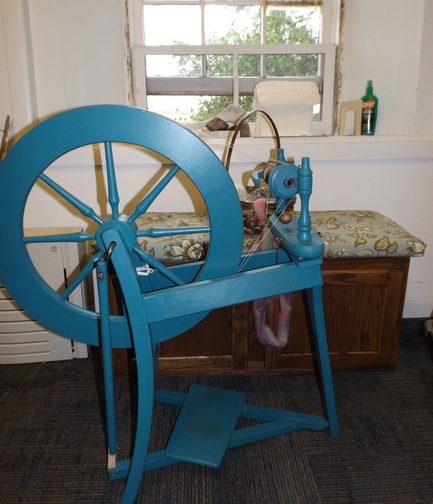 Welcome back! Well, at least to me. I’ve been slacking. Okay, that’s not completely true. I have been spinning lots of yarn, dyeing lots of wool, and knitting a sweater (the Terra Linda Cardigan if you’re interested.) Last month I also was gifted a spinning wheel, my third one. She’s an Ashford Traditional, first purchased by the original owner in 1976. She was originally dark walnut, but I painted her teal and she’s used for demonstrations sometimes. Her color, incidentally for those who are fans of Daryl’s Restoration Over Hall on DIY network, is the same as the reproduction historic sink in the new kitchen. She’s supposed to represent something from the 1800s and I spend a lot of time explaining that the color is, yes, historically correct. It's a bit darker than pictured. I also spend a lot of time explaining the theory of spinning yarn- the how to's and different types of wool. One family found out I can ramble if you let me. Her name is Charlotte. If you’re wondering, and if you’re not, the dark walnut bench behind it was something that I built from a kitchen cabinet I got from Menards. I needed something to #1- store wool, and #2, be the right height to sit and spin. I find around 17 inches tall is the right height for me. At some point I will give a thorough review. And at some point I will give a history lesson on historic painted spinning wheels. Actually, I’ll do that right now. I’ve been researching spinning wheels lately- forms, styles, and colors. While a vast majority of wheels are natural wood colors, I have found two colors that predominate when they are painted- shades of medium-dark blues and greens. I found one with burgundy trim. Since I can ramble on about anything spinning related I will stop now. See you soon! 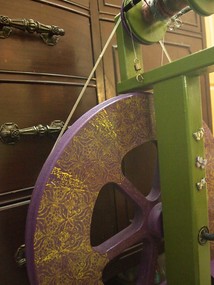 I have 2 spinning wheels (right now). My first one was a Louet S17 single treadle which I wrote about previously. My new wheel, received last August, is an Ashford Kiwi 2. I got the unfinished one so I could paint it myself. Ashford changed some features from the original Kiwi, which I did consider 10 years ago. There is a sliding hook on the flyer which I thought I wouldn’t like but I was wrong. We’ll see if they last 10 years though because they are just wire. The new bobbins are bigger for the sliding hook flyer. I can get a good amount of yarn on them- I’ve got 298 yards of DK weight on one. I was having trouble with the fuzziness of the fluffed locks for my fleecespun art yarns getting caught on the cup hooks at the top of the flyer, so I bent one in to close it. It helps, but it still gets caught once in awhile. The fix is easy and I can fix while the wheel is in motion. Just pull the yarn back towards you and let go to wind onto the bobbin- it has worked every time. The wheel design is also new and I think much prettier than the original. The Kiwi is a Scotch tension wheel, also known as flyer lead. The poly drive band goes around a whorl that attaches to the flyer, there is a clear wire and spring that goes around the bobbin that controls the uptake of yarn on the bobbin. It comes standard with 2 ratios: 5.5 and 7.25. I have used the 5.5 to test it but like the Louet, spin mostly on the 7.25. There is a high speed adapter kit and a jumbo flyer kit available to expand ratios available. I hope to get the jumbo flyer kit for the bigger 8 ounce bobbins, but would also like to get the high speed kit since I spin a lot of sock yarn on this wheel. The higher speed ratio means more turns of the flyer, which means I don't have to wildly treadle to get it fast- the whorl will do it for me. 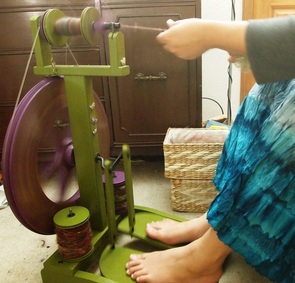 Treadling is very, very smooth and pretty quiet. When it’s not quiet it needs a little oiling as per Ashford's instructions that came with the wheel. I use sewing machine oil I got from Joanns Fabrics. I love the double treadles. I like that I’m using both feet, not just one as on the Louet. Due to a previous accident about three years ago, using both also is just a better idea for me so not to stress out my right foot and leg. As mentioned above, I got the unfinished version. Out of the box the wood is smooth to the touch, the edges are sanded of sharpness. I painted mine in the colors Jungle Green and Blackberry Harvest from Home Depot. The wheel also has a yellow stamped botanical butterfly design on it. It comes flat packed and requires assembly. It has a pegged, hex bolt, and screw construction and once assembled is very sturdy. The base has a square design which adds to its sturdy feel- I never feel this will tip over, even when spinning on carpet. If you get one, have a cordless drill handy because the holes can be tight to screw into. For the beginning of the build all we had was a screwdriver, until we got tired and went and found the cordless. Also have a rubber mallet handy to bang in the pegged joints. I love this wheel. I love the double treadles and the way they just work so well, free, and easy. I love the feel of the wood to the point I want to buy another one just to stain it mahogany (I probably won't, and Ashford Travellers is next on the wish list). It is considered a “beginners” wheel but I would recommend to anyone looking for a double treadle on the lower end of the price scale. It has accessories which add to it's spinning ratios, and the adapters are not expensive so it is versatile. I’ve taken it on a few camping trips and it’s small enough to easily sit on the floor of my friend’s truck. I think because of the quality of build and finish from Ashford it will be durable for the long haul.
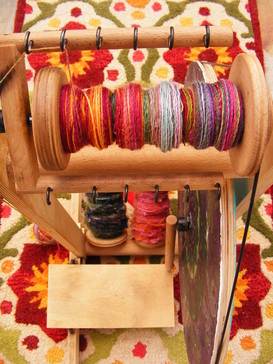 I have two spinning wheels (and about 40 drop spindles, but that’s for another day). A few months ago I got an Ashford Kiwi2, but my first spinning wheel was a Louet S17. It is a simple single treadle model that came flat packed, assembly required, and unfinished. Over the last 10 years later I’ve spun somewhere around 225,000 yards on it. When I received the box I didn’t assemble it right away. I painted the wheel with 2 stylized mandalas, a different one on each side. The rest of the wood I left natural although now I wish I had clear coated the wood. Assembly of the spinning wheel took only about an hour. The wood is a laminated hardwood and it has withstood several household moves and being taken to special events without so much as a scratch. I sanded around the corners because they were very sharp. The ball bearings in the wheel mechanism have always worked incredibly smooth. I only recently have replaced the flyer brake and drive band. Even if you don’t know what those terms mean, in short, I have spun a lot and done very little maintenance on it. The Louet is a bobbin led wheel. What this means is that the drive band goes around the bobbin, which on one end has several grooves. Each of those grooves represents a ratio. Standard Louet S17 bobbins have 5:5, 7:5, 10:5 ratios. Those numbers mean for each turn of the wheel, the bobbin has turned 5 1/2, 7 1/2, or 10 ½ times. Bigger number equals faster speed. My wheel for most of it’s early yardage was on 5:5 ratio. For the last couple years it’s been almost exclusively at 7:5 ratio. 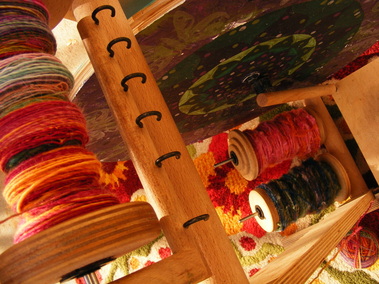 I love this wheel for spinning my fleecespun bulky art yarns which I spin from fluffed fleece. The flyer has a ½ inch orifice so anything, included felted flowers, can easily go through it. The bobbin led system pulls the yarn around the bobbin just better for spinning in the fleecespun style. I’ve tried the same yarn on my Ashford and because it’s a flyer led system it doesn’t have the same pull in as the Louet. This is not to say the Ashford is not a good wheel. It does have a place in my spinning world, which I’ll discuss in a later post. The Louet also has huge bobbins so I can easily fit 100 yards+ of bulky handspun on one. The only thing I would change about the wheel is the treadle. I wish it was a double treadle. My Ashford is a double treadle and I just like it better. Double treadling feels effortless and has less stress on my feet and legs. They do make double treadle Louets with the bobbin led system, which I have looked into along with the Ashford Country Spinner, and the Spinolution Wind, also a bobbin led wheels.
Overall, if you are looking for an entry-level wheel that won’t break the bank I would highly recommend the Louet S17 because of ease of treadling and maintenance, as well as sheer sturdiness. It might not be the most traditional looking wheel, but it will spin many yards of yarn and just keep going. |
AuthorYarn artisan, Spinning Gypsy, lover of all sorts of textile arts Archives
September 2014
Categories
All
|

 RSS Feed
RSS Feed
